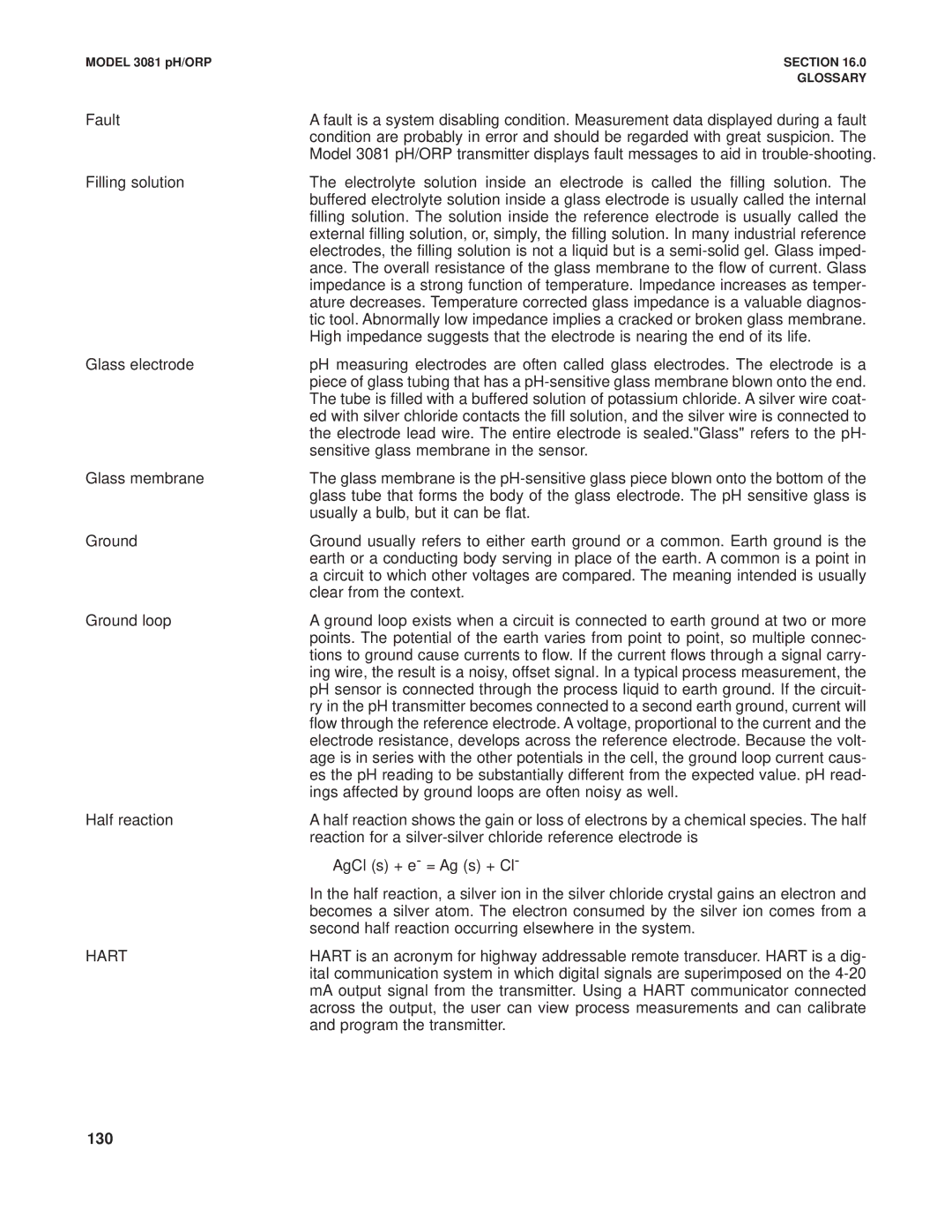MODEL 3081 pH/ORP | SECTION 16.0 |
| GLOSSARY |
Fault | A fault is a system disabling condition. Measurement data displayed during a fault |
| condition are probably in error and should be regarded with great suspicion. The |
| Model 3081 pH/ORP transmitter displays fault messages to aid in |
Filling solution | The electrolyte solution inside an electrode is called the filling solution. The |
| buffered electrolyte solution inside a glass electrode is usually called the internal |
| filling solution. The solution inside the reference electrode is usually called the |
| external filling solution, or, simply, the filling solution. In many industrial reference |
| electrodes, the filling solution is not a liquid but is a |
| ance. The overall resistance of the glass membrane to the flow of current. Glass |
| impedance is a strong function of temperature. Impedance increases as temper- |
| ature decreases. Temperature corrected glass impedance is a valuable diagnos- |
| tic tool. Abnormally low impedance implies a cracked or broken glass membrane. |
| High impedance suggests that the electrode is nearing the end of its life. |
Glass electrode | pH measuring electrodes are often called glass electrodes. The electrode is a |
| piece of glass tubing that has a |
| The tube is filled with a buffered solution of potassium chloride. A silver wire coat- |
| ed with silver chloride contacts the fill solution, and the silver wire is connected to |
| the electrode lead wire. The entire electrode is sealed."Glass" refers to the pH- |
| sensitive glass membrane in the sensor. |
Glass membrane | The glass membrane is the |
| glass tube that forms the body of the glass electrode. The pH sensitive glass is |
| usually a bulb, but it can be flat. |
Ground | Ground usually refers to either earth ground or a common. Earth ground is the |
| earth or a conducting body serving in place of the earth. A common is a point in |
| a circuit to which other voltages are compared. The meaning intended is usually |
| clear from the context. |
Ground loop | A ground loop exists when a circuit is connected to earth ground at two or more |
| points. The potential of the earth varies from point to point, so multiple connec- |
| tions to ground cause currents to flow. If the current flows through a signal carry- |
| ing wire, the result is a noisy, offset signal. In a typical process measurement, the |
| pH sensor is connected through the process liquid to earth ground. If the circuit- |
| ry in the pH transmitter becomes connected to a second earth ground, current will |
| flow through the reference electrode. A voltage, proportional to the current and the |
| electrode resistance, develops across the reference electrode. Because the volt- |
| age is in series with the other potentials in the cell, the ground loop current caus- |
| es the pH reading to be substantially different from the expected value. pH read- |
| ings affected by ground loops are often noisy as well. |
Half reaction | A half reaction shows the gain or loss of electrons by a chemical species. The half |
| reaction for a |
| AgCl (s) + e- = Ag (s) + Cl- |
| In the half reaction, a silver ion in the silver chloride crystal gains an electron and |
| becomes a silver atom. The electron consumed by the silver ion comes from a |
| second half reaction occurring elsewhere in the system. |
HART | HART is an acronym for highway addressable remote transducer. HART is a dig- |
| ital communication system in which digital signals are superimposed on the |
| mA output signal from the transmitter. Using a HART communicator connected |
| across the output, the user can view process measurements and can calibrate |
| and program the transmitter. |
Page 144
Image 144
